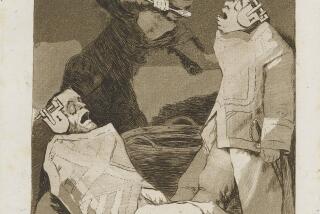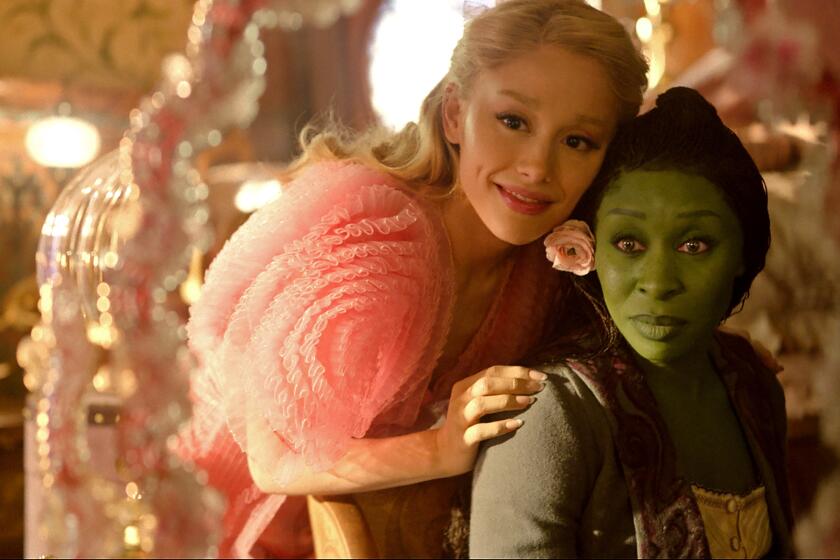Familiar Images
The Weston family name has loomed so large in the annals of fine-art photography that whenever it pops up, so does our name-recognition sensor. So it goes with the current exhibition by Dody Weston Thompson at the Carnegie Art Museum.
Married briefly to Brett Weston--they divorced in 1956--and a protege of famed patriarch Edward Weston, she has been an ardent champion of the photographic medium over the years, writing essays, often in books on the Westons, and co-founding the influential photography magazine Aperture.
Not incidentally, she is also a sensitive practitioner of the art form in her own right, as is shown in this exhibition of work, covering half a century of imagery, from the ‘40s on. Early images find her squarely in Weston turf, with black-and-white works celebrating the stark sensuality of Oceano sand dunes, and one shot, “Brett Weston on the Dunes,” showing a tiny distant figure of her then-spouse, perched at his trusty tripod.
*
Her black-and-white “Ghost in the Kitchen, Nevada,” a simple, rustic scene, hints at her future interest in finding God--or at least artistic inspiration--in the tiny, trivial details of the visual world.
She also ventured into color, with impressive and more personalized results. There are several images here using the Ilfochrome process, with a warm palette of hues that enhances her views of Italy. She is enamored of walls, whose old, lived-in textures, combined with her cropped-compositional eye, suggest an almost dreamlike Old World charm, estranged from the anxieties of the modern day. From her Italian images, circa the ‘70s, she also was drawn to the canals of Venice, dwelling on the rippling imagery and fabled sights of that realm.
Here, her emphasis on the micro rather the macro view rules. An elemental image like “Stern, Gondola, No. 5” says a lot with a little info, mainly the gleaming tip of a gondola against the reflection of an old canal-side building in smooth waters. The upshot: timeless beauty, a glimpse of infinity in the moment.
Closer to home in Los Angeles, Thompson again burrows into visual details in search of expression, ignoring the sprawl and frazzle of the city. The closest she comes to an edgier, socially charged urban scene is in “Love Pump,” a close-up view (of course) of a decaying building with burn marks fanning out from its windows and a bit of graffiti supplying the title of the piece.
Generally, her Los Angeles work leans toward calm observations and gentle modes of abstraction. Her view of the Arco Plaza Fountain, for instance, has no urban visual noise attached. Here, as with her Venetian images, she plays on the innate impressionist look of colors reflected in rippling water. The L.A. of fast, slick energies is a world away. Such is the selective allure of a keen, senses-awakened photographer.
Master, in Poster Mode: Pablo Picasso, revolutionary painter, sculptor, printmaker, draftsman and more, was many things to many observers--the operative word being many.
One of the lesser-known crannies of the Picasso output was his poster-making, the subject of a traveling show assembled at the El Paso Museum of Art and now displayed upstairs at the Carnegie.
It would be unfair to compare this work with Picasso’s better-known and more influential art, but it does offer intrigue as a footnote to his brilliant, long career. It’s also helpful to remember that poster art has enjoyed a more respectable niche in the art world in Europe, compared with the American scene.
*
Some of the examples here advertise Picasso-related exhibitions of his Cubist paintings and more, but the most interesting pieces are his posters made to promote the annual ceramic exhibition in his adopted hometown of Vallauris, France.
These simple line drawings convey a “folkish” personality that is identifiably Picasso’s.
Picasso’s legend preceded and lubricated his public life, to the point where his very signature scrawl commanded attention late in his life.
In the 1961 poster, for “Dibujos de Picasso,” his playful lettering, the text sprinkled with squiggles and asterisks, attains a childlike directness and innocence.
Late in life, Picasso, who died in 1973 at the age of 92, completed the arc of his own evolution, beyond complexity to regain the ingenuousness of youth.
Or perhaps he was shrewd about the power of his name. Or both.
DETAILS
“Reflections, III: Photography by Dody Weston Thompson” and “Picasso Posters: A Study in Design,” through Feb. 27 at the Carnegie Art Museum, 424 S. C St. in Oxnard. Gallery hours: 10 a.m.-5 p.m. Thursday-Saturday, 1-5 p.m. Sunday; 385-8157.
More to Read
The biggest entertainment stories
Get our big stories about Hollywood, film, television, music, arts, culture and more right in your inbox as soon as they publish.
You may occasionally receive promotional content from the Los Angeles Times.










